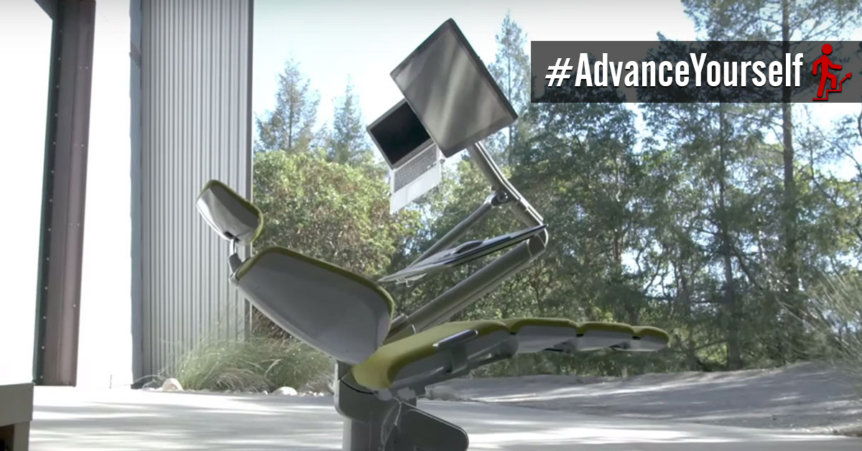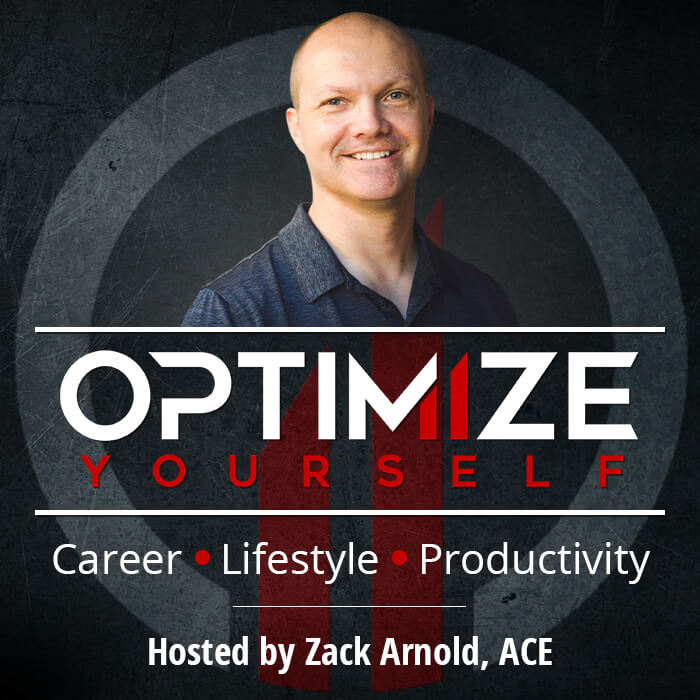For the last several decades we as office dwellers have been on an endless quest for the “perfect” chair that provides the most comfortable working position to alleviate our aches and pains. This search has become so desperate that people are seriously considering spending upwards of $4000 on an office chair that allows you to lie down. While I respect any company genuinely working hard to improve the lives of others, clearly everyone needs to watch WALL-E one more time before this design trend goes deeper down the wrong rabbit hole.
The reality is there isn’t one single best position for you to be stuck in for 10-16 hours per day, no matter how amazingly comfortable or ergonomic it may be. It makes no difference if you’re sitting, standing, or otherwise: Being sedentary for long periods will slowly kill you.
Yet one of the most common questions I’m sent via e-mail and social media is still, “I’m ready to invest a lot of money in the best office chair on the market. What do you recommend?”
If you are ready to spend good money on doing something for your health, don’t blow it on a fancy chair. Instead invest the money in creating a more dynamic work environment. Movement is the best investment you’ll ever make in your health.
“Your best ergonomic position is always your NEXT position.”
– Josh Kerst, Ergonomist
Below I have outlined 5 different ways to reimagine your workspace, improve “traditional” ergonomics, and make your day more active without requiring any real effort. Any combination of these five tips will reap infinitely more long term benefits than spending a mortgage payment on a high tech ergonomic office chair.
1. Introduce ‘NEAT’ movement throughout the day
NEAT is a term coined nine years ago by James Levine, an exercise physiologist at the Mayo Clinic, and it stands for Non-Exercise Activity Thermogenesis. Defined in the simplest terms, NEAT movements are the small, brief, and frequent muscle movements one makes throughout the day. These frequent movements to incorporate into your daily routine can be as simple as:
- Standing up
- Sitting back down
- Bending over to pick something up
- Getting dressed
- Crossing your legs
- Shifting positions often
- Taking walking meetings (especially after eating)
And the best part about NEAT movements? They are FREE. You will reap equal benefits from NEAT movement whether you own a
Think of yourself as the tortoise, not the hare. Sprinting quickly (i.e. exercising vigorously) and then sitting all day long isn’t as beneficial for you as slowly moving constantly throughout the day. If you were to stand once and remain immobile for 30 minutes, or alternatively if you were to stand 15 times throughout the course of those same 30 minutes, the latter would be infinitely more beneficial as you would initiate a shift in fluids, hormones, blood circulation would increase, and more muscle contractions would occur.
In my podcast interview with Ergonomist Josh Kerst, he mentions the “10 and 2” rule, meaning every 10 minutes or so initiate a change in posture for 2 minutes, ideally standing as well (if you’re not already). In addition to having physical benefits, integrating more NEAT activity into your day will have a positive effect on your attention, focus, cognitive function, and creativity as well.
Think twice before investing in any chair or workstation that will promote even less daily movement than you get already.
2. Transition to more ‘dynamic’ seating options
If you’re willing to drop hundreds (or even thousands) of dollars on a single desk chair, why not use that same money to invest in several different seating options that promote better health?
Try integrating more “dynamic” seating options that allow you to “perch” and change positions, reversing the negative physical adaptions caused by sitting, especially the 90º hip flexion and shortening that happens when you’re seated all day long.
Here are my two favorite “dynamic” seating options:
The Mogo
The Pivot
3. Set up a ‘hacked’ standing workstation
While standing is not the ultimate solution to sitting, it is a good first step towards better health. If you’re not ready to make the investment in a standing or height-adjustable workstation quite yet, here are a few options to get you started with a temporary fix.
Use cardboard boxes, milk crates, high-backed chairs, or anything you can get your hands on to raise your keyboard and monitors and give standing a try. Make it easy enough to switch back to sitting so you can alternate back and forth, otherwise you will exhaust yourself and throw the idea out before you’ve really had a chance to test it. At first, you shouldn’t stand for more than 15 minutes out of every hour. Over the course of a month or so, slowly work yourself up to the point of standing for 1 hour at a time without sitting back down.
With the dynamic seating options listed above you can test different heights and positions, and you could even bring in a bar stool or drafting chair to give yourself further standing breaks.
And guess what? You can test all of this out for mere pennies. I know people that have built standing workstations for less than $20. Click here for a $22 standing desk Ikea hack.
BONUS: Here is the cheapest standing desk on the market available in every household and hotel room:

4. Optimize the ergonomics of your standing workstation
If you do choose to set up a more permanent standing (or height-adjustable) workstation, here are a few key points to help you optimize the best position.
Arrange your feet and legs properly (and the world underneath them)
Your body was designed to move over uneven terrain, not stand on flat, even, hard surfaces in one position for long periods of time. Make sure that in general your feet are pointed forwards and parallel to each other. Like a car with poor front-end alignment, having poor foot alignment can lead to unnecessary torque to the legs and hips. Also make sure to frequently change the position of your feet, often adopting the “Captain Morgan’s” pose by using something like an apple box.
Integrating these three tools below can drastically reduce leg fatigue over the course of a long day:
Topo Anti-fatigue Mat
High Density Half Foam Roller
Apple Box
Arrange your shoulders and arms properly
Extend your arms in a comfortable “handshake position” with your thumbs up. Walk to the edge of your desk where you will be standing, and you should be able to shake hands with your keyboard. As Josh Kerst says, “If you can’t shake hands with your workstation, it’s unfriendly.”
Try not to have your mouse or other devices outside your “optimal real estate” space, meaning if you have a number keypad extending past your keyboard and your mouse is placed outside of that, you will have to extend your arm too far out of your comfort zone which can cause health issues after repetitive use all day long.
Your shoulders, elbows, and wrists should form a nice straight line so that if you drew a line through them, it would point to your middle finger. If that’s not the case, rearrange your equipment to get closer to this ideal alignment of the hands and arms.
Lastly, your shoulders should be vertically aligned right over the tops of your hips, not slouched forwards. One way to ensure this happens is the “perching” position that you can get into using the dynamic seating options mentioned earlier.
Arrange your monitors properly
While standing in the proper position in front of your workstation, extend your fist in a punch position. Your knuckles should just barely graze your monitor, and the top of the monitor should be roughly at eye level. Avoid your monitor being too high as this will cause you to crane your neck upwards and put unnecessary torque and tension on your neck and shoulder muscles. This can also cause nerve damage.
5. Rearrange your workspace
How you arrange your workspace beyond just your desk is paramount to promoting more movement, and even more importantly, more respect. When setting up (or rearranging) your workspace, keep these key points in mind:
Make sure you have free space large enough to fit a yoga mat
If you want to be able to take stretching or activity breaks, make sure you have enough free floor space to fit a yoga mat (but you don’t actually need a yoga mat). If you choose to take a quick break but you have to constantly rearrange the furniture in your office, you will make excuses and never do it.
Arrange the placement of frequently used items further away from you
This is an example of actually making your life less efficient. If there is a bookshelf you use 15 times a day to take papers or binders from, put it on the opposite end of the room. If you constantly use your printer, put it in another room or at the opposite end of your room as well. This will promote more habitual and frequent standing, i.e. NEAT movement.
If you work in a bullpen environment where movement is not encouraged, simply put a water bottle in a place where you have to stand to grab it. This will promote more movement in two ways: First you’ll have to stand every time you want a drink, and secondly the more you drink…the more you’ll have to walk to the bathroom to pee!
Place your standing workstation in a position of power
If you are slouched over your sitting workstation with your back to the door and a director or producer walks in, this puts you in a submissive position. Rearrange your workstation so that when somebody walks into your room you are in the position of power. This means you are facing them, (or close to it), and ideally standing. Whether consciously or subconsciously, this will affect the way your colleagues and superiors view you and treat you.
To learn more about the psychological and physiological effects of taking a “power” position, watch this TED Talk with Amy Cuddy.
Want to become an ‘Office Movement Ninja?’
Before dropping $1000 or more on a fancy office chair, consider instead investing in some of the options above, or even better, considering investing in yourself. Learn more about how to become more habitually active while working, because the best office chair is the one you’re not sitting in all day long.
I have spent the last ten years learning everything I can about how to not only survive but thrive in a high stress & sedentary work environment. I know you don’t have time to go to the gym. But I also know that it’s possible to stay healthy and learn to generate ample energy despite our crazy lives, and I want to teach you how to sit less, focus more, and become so active at work you’ll never feel guilty for skipping a day at the gym again.









Comments 2
Pingback: Alleviate Chronic Pain in 5 min a Day...Right At Your Desk
Pingback: Building a Dynamic Workstation On the Go